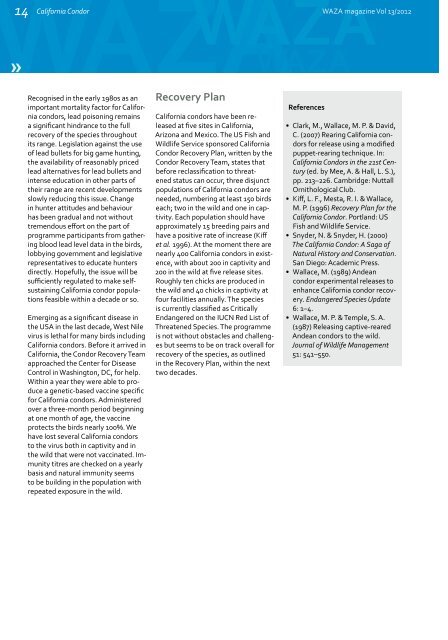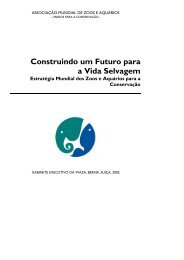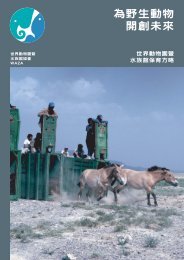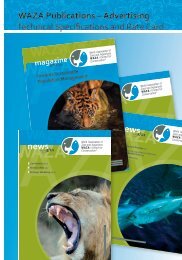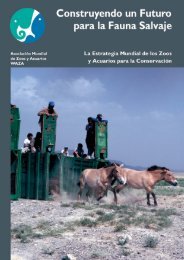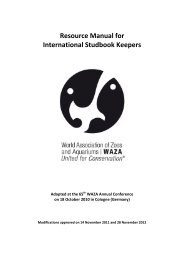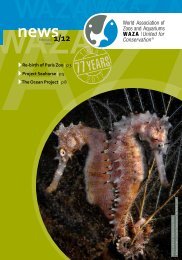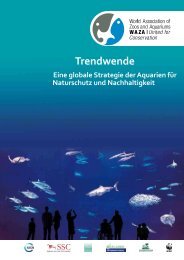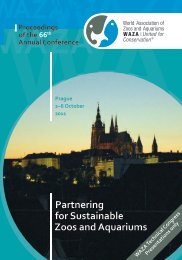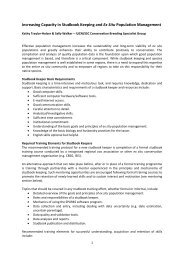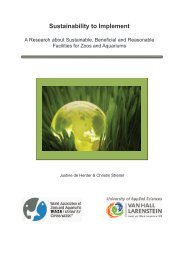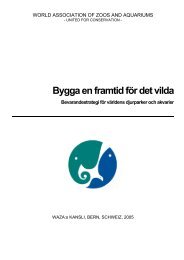Fighting Extinction - Waza
Fighting Extinction - Waza
Fighting Extinction - Waza
Create successful ePaper yourself
Turn your PDF publications into a flip-book with our unique Google optimized e-Paper software.
14<br />
»<br />
California Condor<br />
Recognised in the early 1980s as an<br />
important mortality factor for California<br />
condors, lead poisoning remains<br />
a significant hindrance to the full<br />
recovery of the species throughout<br />
its range. Legislation against the use<br />
of lead bullets for big game hunting,<br />
the availability of reasonably priced<br />
lead alternatives for lead bullets and<br />
intense education in other parts of<br />
their range are recent developments<br />
slowly reducing this issue. Change<br />
in hunter attitudes and behaviour<br />
has been gradual and not without<br />
tremendous effort on the part of<br />
programme participants from gathering<br />
blood lead level data in the birds,<br />
lobbying government and legislative<br />
representatives to educate hunters<br />
directly. Hopefully, the issue will be<br />
sufficiently regulated to make selfsustaining<br />
California condor populations<br />
feasible within a decade or so.<br />
Emerging as a significant disease in<br />
the USA in the last decade, West Nile<br />
virus is lethal for many birds including<br />
California condors. Before it arrived in<br />
California, the Condor Recovery Team<br />
approached the Center for Disease<br />
Control in Washington, DC, for help.<br />
Within a year they were able to produce<br />
a genetic-based vaccine specific<br />
for California condors. Administered<br />
over a three-month period beginning<br />
at one month of age, the vaccine<br />
protects the birds nearly 100%. We<br />
have lost several California condors<br />
to the virus both in captivity and in<br />
the wild that were not vaccinated. Immunity<br />
titres are checked on a yearly<br />
basis and natural immunity seems<br />
to be building in the population with<br />
repeated exposure in the wild.<br />
Recovery Plan<br />
California condors have been released<br />
at five sites in California,<br />
Arizona and Mexico. The US Fish and<br />
Wildlife Service sponsored California<br />
Condor Recovery Plan, written by the<br />
Condor Recovery Team, states that<br />
before reclassification to threatened<br />
status can occur, three disjunct<br />
populations of California condors are<br />
needed, numbering at least 150 birds<br />
each; two in the wild and one in captivity.<br />
Each population should have<br />
approximately 15 breeding pairs and<br />
have a positive rate of increase (Kiff<br />
et al. 1996). At the moment there are<br />
nearly 400 California condors in existence,<br />
with about 200 in captivity and<br />
200 in the wild at five release sites.<br />
Roughly ten chicks are produced in<br />
the wild and 40 chicks in captivity at<br />
four facilities annually. The species<br />
is currently classified as Critically<br />
Endangered on the IUCN Red List of<br />
Threatened Species. The programme<br />
is not without obstacles and challenges<br />
but seems to be on track overall for<br />
recovery of the species, as outlined<br />
in the Recovery Plan, within the next<br />
two decades.<br />
References<br />
WAZA magazine Vol 13/2012<br />
• Clark, M., Wallace, M. P. & David,<br />
C. (2007) Rearing California condors<br />
for release using a modified<br />
puppet-rearing technique. In:<br />
California Condors in the 21st Century<br />
(ed. by Mee, A. & Hall, L. S.),<br />
pp. 213–226. Cambridge: Nuttall<br />
Ornithological Club.<br />
• Kiff, L. F., Mesta, R. I. & Wallace,<br />
M. P. (1996) Recovery Plan for the<br />
California Condor. Portland: US<br />
Fish and Wildlife Service.<br />
• Snyder, N. & Snyder, H. (2000)<br />
The California Condor: A Saga of<br />
Natural History and Conservation.<br />
San Diego: Academic Press.<br />
• Wallace, M. (1989) Andean<br />
condor experimental releases to<br />
enhance California condor recovery.<br />
Endangered Species Update<br />
6: 1–4.<br />
• Wallace, M. P. & Temple, S. A.<br />
(1987) Releasing captive-reared<br />
Andean condors to the wild.<br />
Journal of Wildlife Management<br />
51: 541–550.


